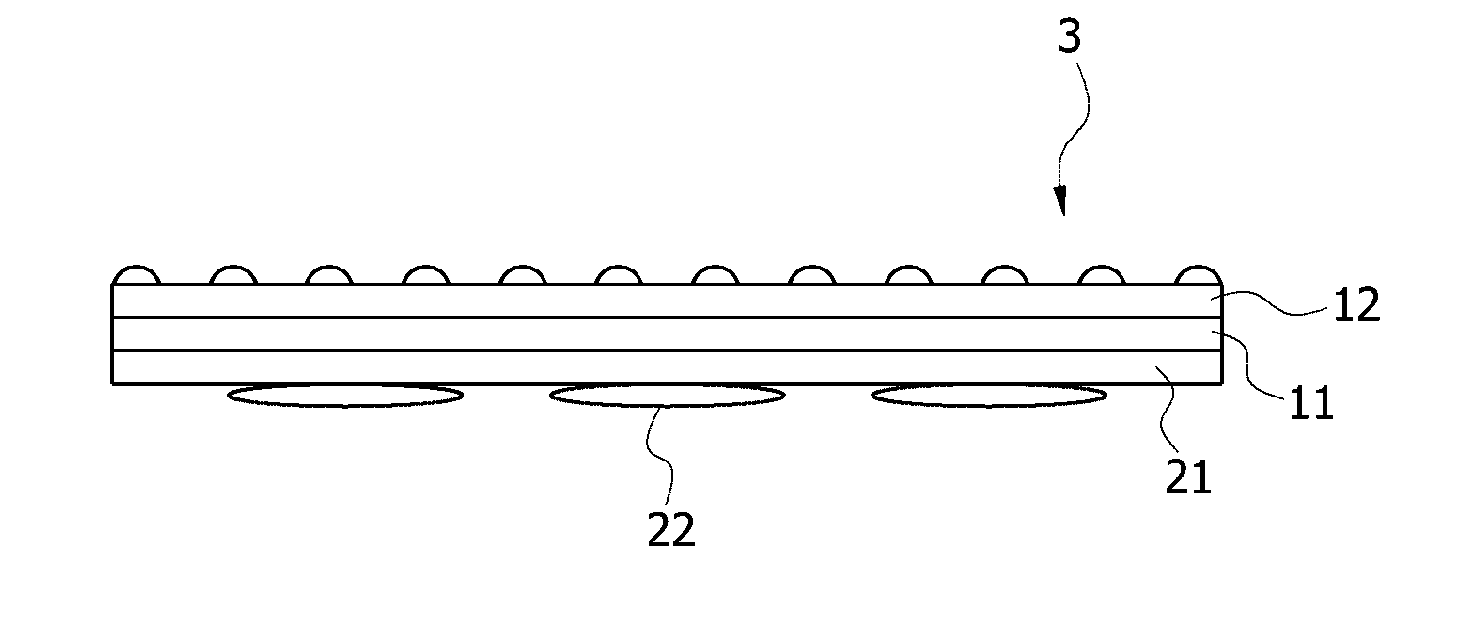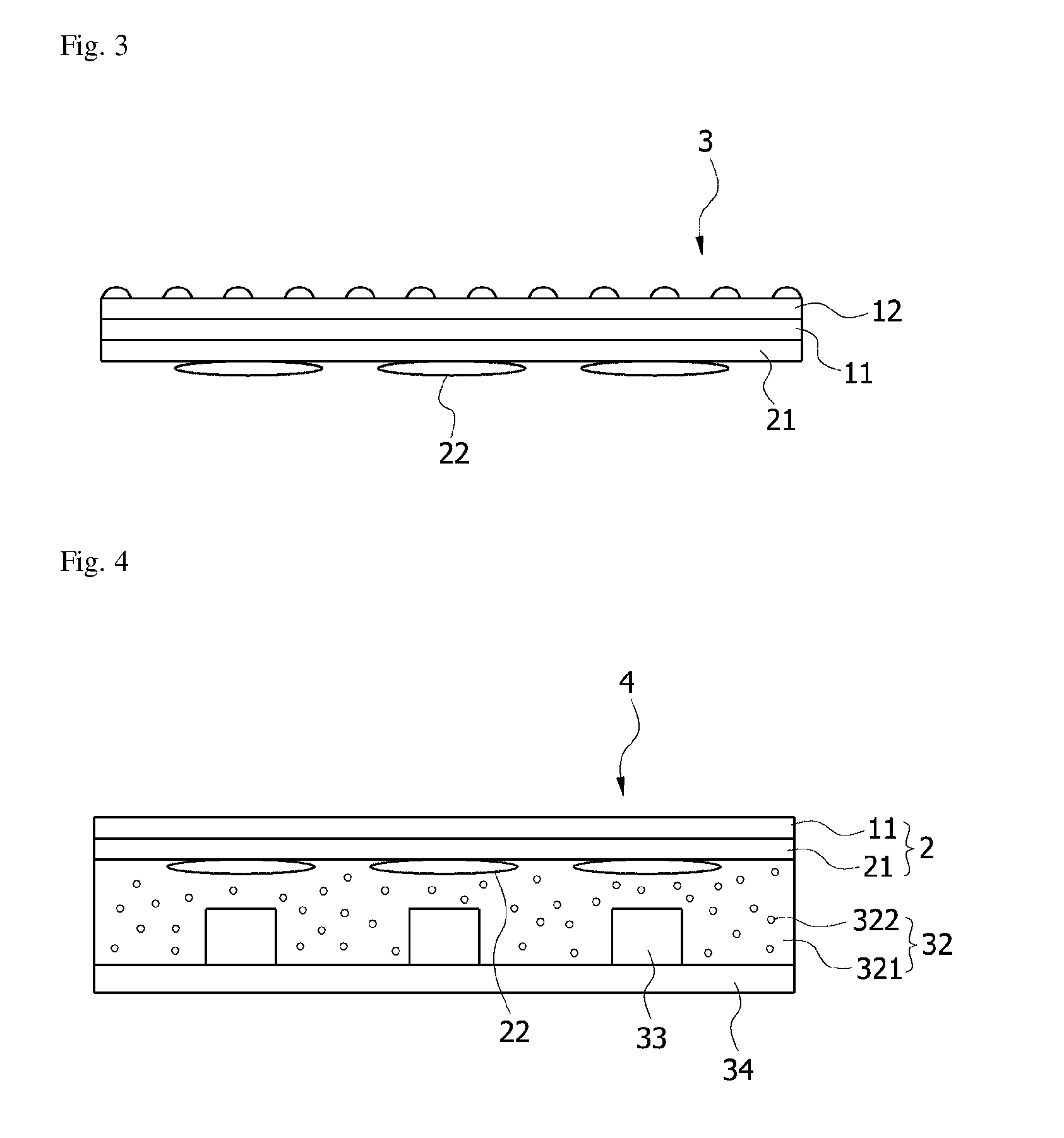Pressure-sensitive adhesive composition
a technology of adhesive composition and pressure, applied in the field of pressure-sensitive adhesive composition, can solve the problems of reducing process efficiency, affecting the luminance of light sources, and affecting the quality of adhesives, etc., and achieve the effects of reducing adhesive properties, excessively high and excessively low scattering particle weight ratio
- Summary
- Abstract
- Description
- Claims
- Application Information
AI Technical Summary
Benefits of technology
Problems solved by technology
Method used
Image
Examples
example 1
Preparation of First Pressure-Sensitive Adhesive Pad
[0084]A monomer mixture was prepared by mixing 75 parts by weight of ethylhexyl acrylate, 15 parts by weight of acrylic acid and 10 parts by weight of hydroxyethyl acrylate. As an initiator, a suitable amount of di(2-ethylhexyl) peroxydicarbonate (EHPDC) was added to the monomer mixture, and the mixture was bulk-polymerized to have a viscosity at 25° C. in a range of approximately 2,000 to 2,500 cps, thereby preparing a photocurable syrup. With respect to 100 parts by weight of the syrup, 0.7 parts by weight of a photoinitiator (2,4,6-trimethylbenzoyl diphenyl phosphine oxide, TPO), 0.3 parts by weight of 1,6-hexanediol diacrylate (HDDA), 15 parts by weight of scattering particles (refractive index: 1.59, average diameter: 4,000 nm, polystyrene-based beads, HR-59-40, Sunjin Chemicals Co., Ltd.) and 1 ppm of a dye (Blue dye, MACROLEX Blue RR Gran, Lanxess) were mixed, thereby preparing a pressure-sensitive adhesive composition. The ...
example 2
[0087]A monomer mixture was prepared by mixing 70 parts by weight of ethylhexyl acrylate, 10 parts by weight of acrylic acid, 10 parts by weight of hydroxyethyl acrylate and 10 parts by weight of 2-(2-ethoxyethoxy)ethyl acrylate, and bulk polymerization was performed by the substantially same method as described in Example 1 to prepare a photocurable syrup. In the above, polymerization conditions were controlled for the syrup to have a viscosity at 25° C. in a range of approximately 3,000 to 3,500 cps. With respect to 100 parts by weight of the syrup, 0.7 parts by weight of a photoinitiator (2,4,6-trimethylbenzoyl diphenyl phosphine oxide, TPO), 0.2 parts by weight of 1,6-hexanediol diacrylate (HDDA), 15 parts by weight of scattering particles (refractive index: 1.59, average diameter: 4,000 nm, polystyrene-based beads, HR-59-40, Sunjin Chemicals Co., Ltd.) and 0.6 ppm of a dye (Blue dye, MACROLEX Blue RR Gran, Lanxess) were mixed, thereby preparing a pressure-sensitive adhesive com...
example 3
[0088]A monomer mixture was prepared by mixing 60 parts by weight of ethylhexyl acrylate, 10 parts by weight of acrylic acid, 10 parts by weight of hydroxyethyl acrylate, 10 parts by weight of 2-(2-ethoxyethoxy)ethyl acrylate and 10 parts by weight of isobornyl acrylate, and bulk polymerization was performed by the substantially same method as described in Example 1 to prepare a photocurable syrup. In the above, polymerization conditions were controlled for the syrup to have a viscosity at 25° C. in a range of approximately 3,000 to 3,500 cps. With respect to 100 parts by weight of the syrup, 0.7 parts by weight of a photoinitiator (2,4,6-trimethylbenzoyl diphenyl phosphine oxide, TPO), 0.3 parts by weight of 1,6-hexanediol diacrylate (HDDA), 12.5 parts by weight of scattering particles (refractive index: 1.59, average diameter: approximately 3,000 to 4,000 nm, polystyrene-based bead, GS-0459S-6, Granz) and 1 ppm of a dye (Blue dye, MACROLEX Blue RR Gran, Lanxess) were mixed, thereb...
PUM
| Property | Measurement | Unit |
|---|---|---|
| Temperature | aaaaa | aaaaa |
| Percent by mass | aaaaa | aaaaa |
| Percent by mass | aaaaa | aaaaa |
Abstract
Description
Claims
Application Information
 Login to View More
Login to View More - R&D
- Intellectual Property
- Life Sciences
- Materials
- Tech Scout
- Unparalleled Data Quality
- Higher Quality Content
- 60% Fewer Hallucinations
Browse by: Latest US Patents, China's latest patents, Technical Efficacy Thesaurus, Application Domain, Technology Topic, Popular Technical Reports.
© 2025 PatSnap. All rights reserved.Legal|Privacy policy|Modern Slavery Act Transparency Statement|Sitemap|About US| Contact US: help@patsnap.com



